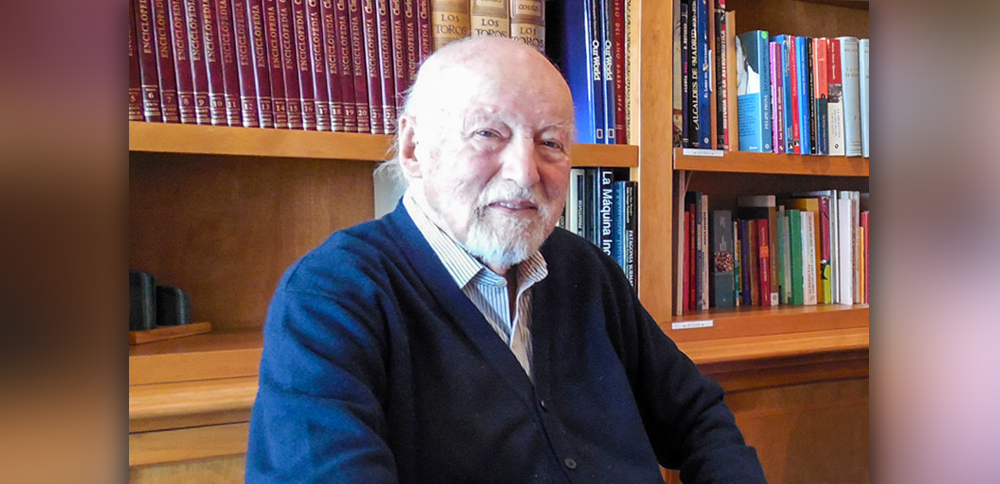By Dom Serafini
Pedro Simoncini was involved with Canal 11, a local TV channel in Buenos Aires, from 1957 until 1993. In 1989, he used the channel as the flagship station for today’s Telefe TV Network.
The last time I saw Simoncini was in September 2017 at his Avenida Belgrano office in Buenos Aires, Argentina. “Nowadays, I come to the office just in the mornings, and am always accompanied because I feel unwell, and since last year, I can no longer drive. I never imagined that being old was so hard,” he confessed. But despite it all he looked good for a 94-year-old man (as the above photo attests). He seemed as solid as a rock and rocked the same sense of humor that he had when I first met him 35 years earlier. It took an additional three years for him to peacefully succumb to his illness on August 29.
Simoncini’s story is rich in drama (military takeovers), financial intrigue (persuading 120 investors to agree on a single strategy), international diplomacy (securing the U.S.-based ABC-TV’s investment), religious harmony (a Jesuit-owned station vs. Jewish-owned stations), historical decisions (picking the color-TV standard), and politics (dealing with Evita Perón).
Simoncini was known internationally — especially in the U.S. and Argentina — as a broadcasting pioneer. However, his initial ambition was simply to produce and distribute educational TV programs, which he started doing in 1978 in Buenos Aires with Programas Santa Clara. That was around the same time that he started attending MIP-TV, bringing along his little daughter, Karin. Earlier, in 1964, Simoncini was among the first broadcasters to attend what are now called the L.A. Screenings.
In those years, 1974-1980 specifically, Simoncini also served as president of the Asociación de Teleradiodifusoras Argentinas, representing the interests of his own TV station, Canal 5, located in the city of Rosario.
When “Pietro” Simoncini left his native Naples, Italy for Argentina in 1924, he was just one year old. His parents decided to return to Naples the following year, but later went back to Argentina, permanently settling in Buenos Aires in 1927.
Let’s now jump forward a few years to 1943, to find Pietro, now known as Pedro, employed by Banco Italiano in Buenos Aires and tasked with paying a salary to actress and radio personality Eva Duarte (the future Evita Perón) on behalf of Bulgarian immigrant Jaime Yankelevich (1896-1952), owner of Radio Belgrano.
Following the 1958 democratic elections, Simoncini was tasked with maintaining harmony among all the Canal 11 investors, who, he remembered, “saw the channel mainly as the call to fame for their wives and children.” Short on funds, Canal 11 had to find other investors to finance programming, and knowing that the U.S. TV networks were looking for investments in South America, Simoncini secured ABC as an investor.
In 1973, all three Buenos Aires channels were nationalized when Juan Perón returned as president for the third time. Four years later, the U.S. broadcasting, producing, and distribution company Metromedia appointed Simoncini as Program Sales representative for Argentina, Paraguay, and Uruguay.
With the return of democracy in 1983, President Raúl Alfonsín licensed Canal 9 back to its former owner, Alejandro Romay, in 1984. Canal 11 and Canal 13 both remained government-owned until 1989. When the following president, Carlos Menem, re-privatized the TV stations, Canal 13 went to Clarin and Canal 11 went to Editorial Atlántida.
In 1972, Simoncini became a Canal 11 shareholder, and in 1975, the majority shareholder (70 percent), as well as president of Rosario’s Canal 5 and a minority shareholder at other TV stations in Córdoba, Resistencia and Neuquén.
In 1989, he grouped Canal 5 and others in which he had investments with Canal 11 in Buenos Aires to form Television Federal S.A., or Telefe, which, Simoncini explained, “did not denote Tele Fede (Faith), but federal television, as it covered much of the country.”
In effect, 29 years after creating harmony among the original 120 investors of Canal 11, Simoncini returned to the TV channel with the task of putting together a similar number of partners to create Telefe with Canal 11 in Buenos Aires as the flagship station.
He “retired” in 1993, and five years later the network was sold to Spain’s Telefonica. Today, Telefe is owned by ViacomCBS.
Simoncini “retired,” but only from the commercial sector, because, in 1992, he founded TV Quality, a production company for educational programs, thereby returning to his first love. In 1994, he founded Educable, which distributed cultural and educational programs to various cable TV networks. Just before leaving Telefe, Simoncini became president of Fundación Compromiso, an association of not-for-profit companies, a position he held up until the year 2000.
Simoncini’s only child, Karin, began her TV career just after college in 1992 at Teleinterior, a content distribution company, and two years later she joined her father at TV Quality. In 2000, she went to work at National Geographic in Washington, D.C., and in 2010 to Australia for FOX Channels. Since 2014, she has been at ZooMoo Networks as head of Programming.
Of those early years with her father, Karin remembered, “He was a tough boss, but an inspiring one. What I most admired in him was that he was such a lateral thinker.”


Leave A Comment